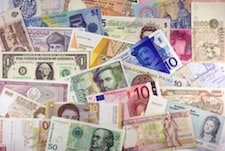 |
|
|
For a global power management company like Eaton, which generated $21.8 billion in revenues last year selling products to clients in 175 countries, managing foreign exchange (FX) risk exposure is crucial. When the company acquired $5 billion-in-revenues Cooper Industries, a fellow power management vendor, in late 2012, the task only became more complicated. The Cooper acquisitionbrought in a couple of currencies,like the Philippine peso and Saudi riyal,to which we did not have exposure previously, notes Robert Elliott, vice president and assistant treasurer at Eaton.
Eaton tracks 30 currencies in its portfolioand plans to continue its practice in view of the current FX correlation trends, says Elliott. Indeed, vastly increased FX volatility in the past few years, on the back of ongoing global financial and political crises, has ended the historical correlations between many currency pairs.
In the past, companies operating in various locales might have made use of correlations to hedge only against certain key currencies. But no more.
When it comes to reducing Eatons FX risk exposure, the companys policy is to fully hedge all the time, according to Elliott. Eaton hedges 100% of its balance sheet exposure. Sometimes in the clear light of day, we see that we have hedged 90% or 110%, but we always do our best, he explains. The company tends to underhedge its anticipatory hedges to ensure it does not run afoul of the hedge accounting principles found in the Financial Accounting Standards Boards Statement 133 (FASB 133).
Eaton is not alone in its 100% hedge policy. According to Ivan Asensio, senior vice president for FX risk advisory and sales structuring at HSBC, more and more companies are hiking their discretionary hedging ratio. Where businesses might have once hedged 50% of their revenues in particular areas, they are now hedging up to 60% or 70%. This strategy protects the bottom line.
Like most corporations since the 2008 financial crisis, Eaton sticks to simple hedging instruments. It always uses standard currency forwardsor nondeliverable forwards (NDFs)when necessary. Eaton prefers to steer clear of currency options or swaps, which Elliott defines as long-term derivatives trades with periodic cash settlements.
The other vanilla hedging method used by companies: borrowing local currency to hedge conversion exposure.
Banks are busy developing new strategies that will allow companies to hedge different exposures, according to Paul Bramwell, senior vice president for treasury solutions at SunGards AvantGard corporate liquidity business. You also see companies asking for things like straddles as well as nonvanilla options like barriers, knock-ins and knockouts Corporations may have problems with these sorts of instruments due to hedge accountings treatment of them.
Under FASB 133 and other accounting standards for hedges, a company must show or prove sufficient correlation between a particular hedging strategy and the exposure that is being mitigated. Simple hedging instruments like a currency forward or option are not required to meet the same strict standard.
If a company cannot show the correlation relationship between the underlying hedge and the exposure and there is a change in the market value in that hedge, it goes to the companys P&L, explains Bramwell. You still see some of these instruments used, but we see our clients using vanilla forwards and currency options mostly.
Sidebar
Know Your Exotics
Although most businesses use typical FX forwards, FX nondeliverable forwards (NDFs) and FX options because of their more straightforward treatment by most accounting regimens, alternatives do exist. These options offer functions and features that vanilla instruments lack. They come with a price, however. Accounting for exotic hedges can be a complicatedoften trickymatter. Corporate treasuries contemplating the use of exotics should think long and hard about whether they will be able to maintain the proper care and feeding of these instruments. Hereare a few of the more popular exotic FX options used for hedging purposes:
Barrier Options:
These options have an embedded price level, or barrier, that will create or eliminate a vanilla option when reached.
Knock-in Options:
When purchasing knock-in options, an investor can select one of the instrument’s two embedded price barriers. If the investor selects the upper price barrier and the currency’s price reaches the barrier, it creates a vanilla option with the initially negotiated maturity data and strike price. This is known as an “up and in.” The “down and in” is similar but the currency price needs to reach the lower price barrier to create the vanilla option.
Knock-out Options:
A mirror image of knock-in options, knock-outs start as vanilla options with two embedded price barriers. When the currency price hits either the upper barrier, “up and out,” or the lower barrier, “down and out,” it cancels the options contract.
One-touch Options:
An option with an embedded price barrier. If the price of the underlying instrument breaks the barrier, then the option pays out the agreed-upon sum.
Quantity-adjusted Options:
Known as “Quantos,” these instruments are cash-settled, cross-currency options that settle in a currency other than the one in which the underlying instrument is denominate.



